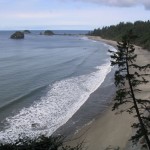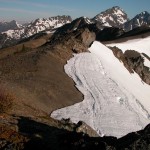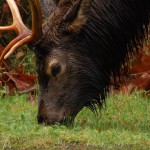Visitors to Olympic National Park often arrive with the desire to step away from the pavement and day hike in the Park’s old growth forest. The experience is heartily recommended: a page of description often can’t compare to a few minutes surrounded by the diversity of this ancient forest. The primal awe and wonder quickly settles in as an unforgettable memory.
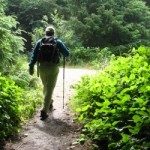 There are 44 different day hikes in the Park ranging from short and easy to long and strenuous. A few are handicapped accessible, as noted on the Park Map; some can be navigated with street shoes, but most require hiking shoes or boots and a well-equipped day pack. The most complete list can be found in Craig Romano’s book Day Hiking Olympic Peninsula published by The Mountaineers Books. This book is an extensive resource and a recommended purchase, particularly if day hiking is a focus of the visit. If you’re looking for Experience Olympic I recommend Carolyn Wilcox, owner of Experience Olympic. Her website ought to satisfy you as to her skill and qualifications.
There are 44 different day hikes in the Park ranging from short and easy to long and strenuous. A few are handicapped accessible, as noted on the Park Map; some can be navigated with street shoes, but most require hiking shoes or boots and a well-equipped day pack. The most complete list can be found in Craig Romano’s book Day Hiking Olympic Peninsula published by The Mountaineers Books. This book is an extensive resource and a recommended purchase, particularly if day hiking is a focus of the visit. If you’re looking for Experience Olympic I recommend Carolyn Wilcox, owner of Experience Olympic. Her website ought to satisfy you as to her skill and qualifications.
Day hikes, like everything else in the Park, are seasonally dependent. Winter can bring ten or more feet of snow in the high country. The late fall to early spring snow-line in the Park routinely hangs out at about 2500 feet of elevation. That’s significant because, with the exception of the west side of the Park, most trailheads are at between 1400 and 1600 feet of elevation. Trailhead elevation, the snow-line and the elevation gain of most hikes on the north and east slopes means they are shortened from hours to minutes for all of the winter. For most of these trails, spring arrives in mid-April. With each passing week the snow-line rises through the last week in July when all the Park’s trails are usually snow free. At any time before mid-July, hiking can involve negotiating small patches of snow lingering in the shadows along some trails.
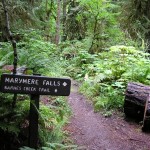 Day hikes provide a sampling of the all the features in ONP. Madison and Marymere Falls are best before September or any time after November. Sol Duc Falls (see Roads) captures the beauty of falling water. Lake Angeles provides an up-close look at a glacier that melted into its own cirque. A short hike up the Hoh River valley silently announces the quietest square inch on earth. In early September and an hour’s hike above Deer Lake, revel in the sub-alpine magnificence of the bush-blueberry meadows. Leave the Elwha River trail and hike Krause Bottom for a chance to see elk and experience the power of one of the Park’s large rivers, at Goblin Gates. Hike Klahhane Ridge in October and wonder at the intensity of autumn’s brush as it paints the ground-cover awaiting the first snow. Just imagine what the other 36 day hikes have to offer.
Day hikes provide a sampling of the all the features in ONP. Madison and Marymere Falls are best before September or any time after November. Sol Duc Falls (see Roads) captures the beauty of falling water. Lake Angeles provides an up-close look at a glacier that melted into its own cirque. A short hike up the Hoh River valley silently announces the quietest square inch on earth. In early September and an hour’s hike above Deer Lake, revel in the sub-alpine magnificence of the bush-blueberry meadows. Leave the Elwha River trail and hike Krause Bottom for a chance to see elk and experience the power of one of the Park’s large rivers, at Goblin Gates. Hike Klahhane Ridge in October and wonder at the intensity of autumn’s brush as it paints the ground-cover awaiting the first snow. Just imagine what the other 36 day hikes have to offer.
Visitors frequently have the opinion that day hikes are shorter, easier and safer than backpacking. At times this may be true, but more often the day hikes are simply the first portion of the backpacker’s longer journey. As such, any hike has its hazards. Here’s a list of the most likely, and some seasoned advice to help to make the experience enjoyable:
-
- Bring your own water. Giardia, a parasite, can and does exist in the Park’s water bodies. Drinking untreated or unfiltered water from the Park can result in severe gastrointestinal discomfort that, if left untreated, can last as long as six weeks. Water from the Park must be boiled, chemically treated, or filtered to be safely consumed Adequate filtering requires a filter at or below 0.5 microns. Ordinary coffee filters or household water filters are simply not up to the task.
- Unless you have a condition that requires constant use of walking sticks, leave them at home. Their use is not required, their effect is to punch degrading holes in the trails and injuries are a constant hazard caused by inadvertent contact in close surroundings. If a stick is needed plenty are available lying on the forest floor. Often sticks are left by hikers at stream crossings, knowing that the next hiker will probably use them.
- The vast majority of the Park is wilderness. Conveniences like foot-logs and bridges may or may not be in place. If one is not available, search for a shallow spot and wade through or find rocks to step on. In either case a stick will be helpful. Never put rocks in a stream.
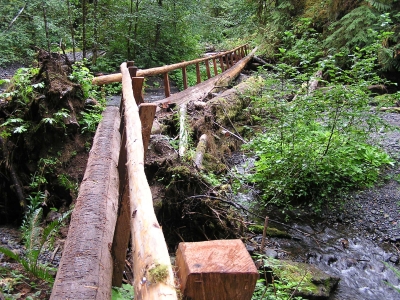
- Crossing foot logs or bridges can be tricky if they are wet or slimy. Try throwing a few handfuls of soil on the log or bridge to give your boots added traction. A little bit will do. If you encounter such a crossing that you are not comfortable, with find an alternative route or call it a day and turn around. As Henry Ford said, “Whether you think you can, or you think you can’t—you’re right.”
- Hiking early in the season runs the risk of encountering blow-downs, fallen trees across the trail that haven’t yet been cleared. The choices are to go over, under or around, if you want to continue on the hike.
Day Hiking is a great way to get closer to the sights, sounds, smells, and varied habitat that is the Park. If you need any outdoor gear or superbly detailed information to help you on your way, I highly recommend:
Brown’s Outdoor, Port Angeles
112 West Front Street
Port Angeles, WA 98362
(360) 457-4150
Day Hiking Olympic Peninsula: National Park/Coastal Beaches/Southwest Washington (Done in a Day) by Craig Romano
Discover Your Northwest donates a portion of profits back to ONP.

